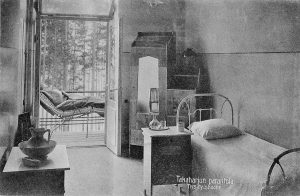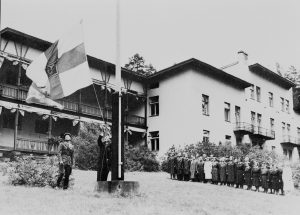Punkaharju – the Most Beautiful Place in Finland
It was June 29, 1842 when, according to a decision made by Nikolai I, Tsar of Russia, Punkaharju was declared the first Crown Park in Finland. Earlier on, in 1803, the young Tsar Alexander I (brother of Nikolai I) was so enraptured by Punkaharju that he had given an oral order forbidding the cutting and burn-clearing of the trees in the area around the esker. Perhaps a stronger incentive for the ban was the fact that the road was flanked by extremely steep, bare slopes which presented a danger to travellers.
Growth in the rate of travel to Punkaharju was especially expedited by three factors: First of all, the Finnish national poet, J.L. Runeberg determined the ideal Finnish landscape: a summer view of a glistening lake from a high vantage point. The first poem “Vårt Land” (“Our Land”) in Runeberg’s “Fänrik Ståls sägner” (“The Tales of Ensign Stål”) was an ode to this national landscape, and “Maamme” (“Our Land” in Finnish) is nowadays sung as the Finnish national anthem. Secondly, another contemporary of Runeberg, the famous newspaper man and author, Zacharias Topelius, raised awareness of Punkaharju as the most beautiful landscape and “Nature’s most beautiful amusement park” – which absolutely everybody should see. Thirdly, the improved accessibility of Punkaharju served as a major factor for the increased attraction of the area to visitors. The water channel from Savonlinna to Punkaharju was beaconed in the 1870s and regular ship traffic was initiated along the route. A tremendous boost for travel was brought on by the opening of train traffic from Elisenvaara to Savonlinna in 1908. Thus Punkaharju and its national landscape became much more accessible to Finnish visitors and the wealthy residents of St. Petersburg, who sought the peace and quiet of nature that could be found here.
Unfortunately, the beginning of World War I, the Russian revolution in 1917, and the 1918 Finnish civil war resulted in travel being restricted and put a temporary end to the thriving travel industry in Punkaharju. However, travel began to flourish anew in the mid-1920s.
Takaharju Tuberculosis Sanatorium
Pulmonary TB was a difficult disease to control with broad repercussions among the nationals in Finland in the 1800s, and no effective medication was available at the time. Wealthy patients could travel to the Alps for treatment at any of the many sanatoriums there, but generally people had no choice but to stay in their home country and simply bear the brunt of the disease. Patients were prescribed rest, nutritious food, and so-called “hall-lying” in the fresh outdoor air throughout the four seasons of the year. In 1892, the “Lääkäriseura Duodecim” (“Medical Society Duodecim”) established the “Osakeyhtiö Keuhkotautisten Parantola” (“Sanatorium of the Pulmonary Diseased Ltd”) who acquired a plot of land – Takaharju, in the vicinity of the Punkaharju esker. The Takaharju Sanatorium buildings were designed by architect Onni Törnqvist (later Tarjanne). The foundation stone was laid in the presence of a prestigious group of guests on July 15, 1901, and the sanatorium opened on October 1, 1903. The building accommodated approximately 100 patients, and it was equipped with modern electric lighting and central heating.

During its first 15 years of operation, numerous foreign patients from all around Russia were cared for at Takaharju, the majority of these patients arriving from nearby St. Petersburg. Most often these patients were wealthy and rented a private room at the sanatorium. Foreign patients were usually accompanied by a number of friends and family who stayed at the nearby State Hotel or Hotel Finlandia, waiting around in Punkaharju while the patient was receiving treatment at the sanatorium. One of the most famous patients who received treatment at Takaharju was Latvia’s national author, poet and playwright Rudolfs Blaumanis, who died at Takaharju in September, 1908, at the age of 45.
Most of the patients treated at Takaharju were young, aged 20–30, and usually had a commitment of payment for a month -long treatment from their municipality of residence. Emotions among the patients ran high – like a continuous roller coaster ride: one day soaring with hopes of healing, and the next day sinking into deep depression because the treatment did not alleviate their symptoms. Sometimes macabre jokes were made about the deadly serious disease. A band made up of patients was named Jazz Orchestra Basil and in a demonstration organised on the First of May, more rights were demanded for patients. Love affairs flared up and died out during walking trips.
From Military Hospital to Kruunupuisto
The years of war 1939–1944 put a stop to travel and both of the hotels in Punkaharju and Takaharju were transformed into military hospitals. During the Winter War the wounded were brought via railways to the Punkaharju station (nowadays the train stop is named Lusto), from where the soldiers requiring surgery were transferred to the Takaharju hospital. After the war, Takaharju was used by the Finnish defence forces as a pulmonary tuberculosis and military sanatorium. Takaharju was responsible for conducting research on pulmonary diseases among the conscripts who were being treated there. Due to the advancement of care in tuberculosis, the defence forces no longer had use for the Takaharju facilities and they were closed in 1964.

Through an initiative put forward by Erkki Tynkkynen, mayor of Punkaharju, and Urho Kiukas, governor of the Mikkeli province, and with the support of the President of Finland, Urho Kekkonen, the “Fysioterapialiitto” (“Physiotherapy Union”), was established. Fysiaterapialiitto rented the Takaharju facilities and undertook the reparation of the sanatorium building in 1967. The renovation was completed in two stages, in 1969 and 1974. Subsequently, the “Punkaharjun Kuntoutussairaalasäätiö” (“Punkaharju Rehabilitation Hospital Foundation”) was established in 1977. The foundation focused on the rehabilitation of war veterans with the “Sotainvalidien Veljesliitto” (a fraternity for war invalids) and “Keuhkovammaliitto” (“Lung Injury Union”). In 1979, the former senior physician’s residence was refurbished and was named “Urhola” in honour of President Kekkonen, governor Kiukas and the war veterans. The Finnish name Urho, derives from the word “urhea”, meaning brave.
During the 1980s and 1990s the Rehabilitation Hospital Foundation refurbished the old buildings and erected totally new buildings. The first expansion, “Kuntotalo” (Fitness House) was completed in 1980 and was equipped with a swimming pool, saunas, gyms and a variety of therapy rooms. At the same time, the Rehabilitation Hospital Foundation rented the former Hotel Finlandia and converted it into an infirmary for war veterans. Nowadays Finlandia serves as a care home for senior citizens. Reparation work continued in the 1990s, and in 2005 a new restaurant and the hotel reception area were completed. The current name Kruunupuisto – Punkaharjun kuntoutuskeskus (Punkaharju Rehabilitation Centre) was adopted in 2003. The business is operated by Kruunupuisto Oy, established in 2006.